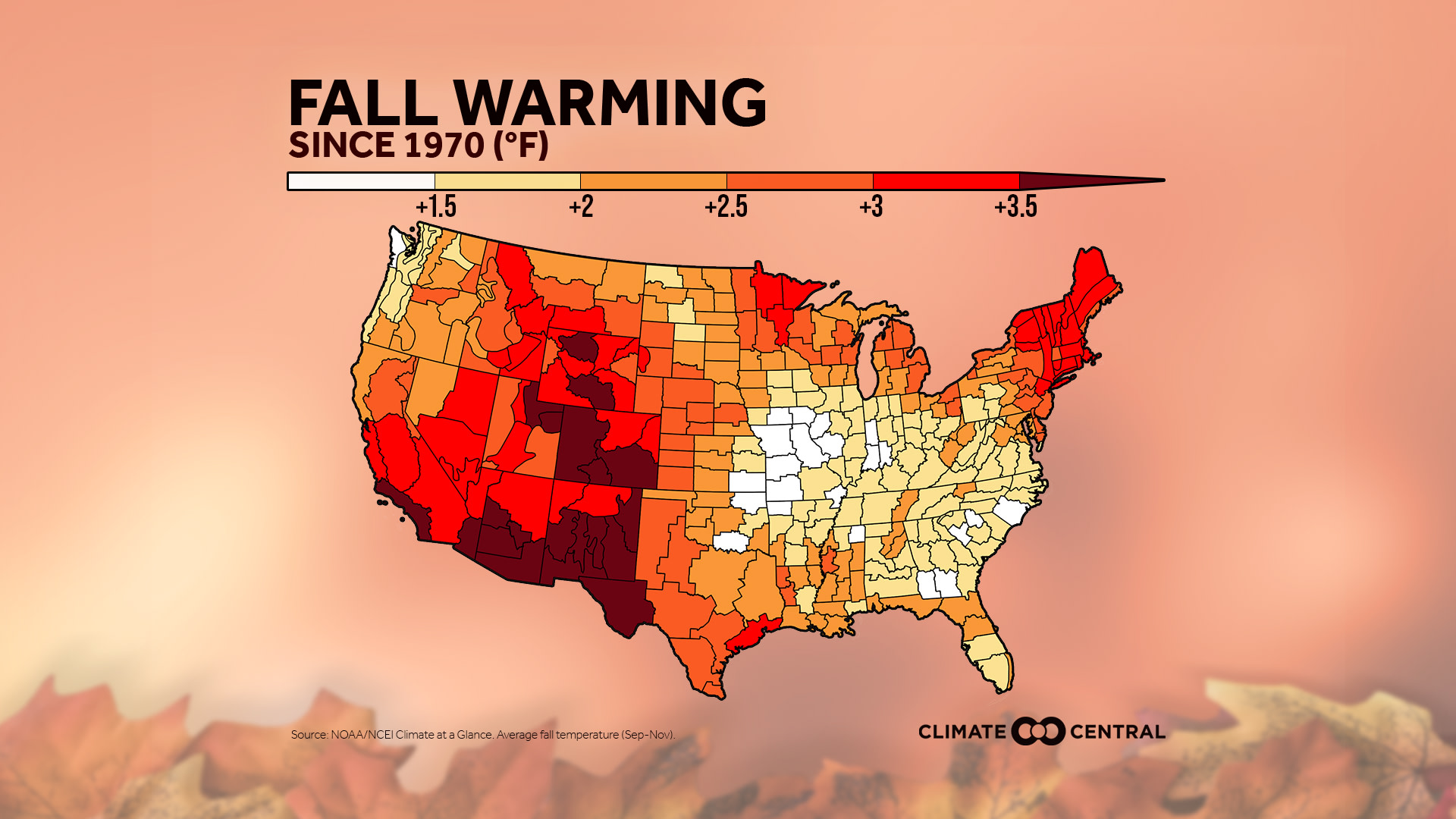THIS IS NOT THE MOST RECENT VERSION AVAILABLE. LINK TO THE MOST RECENT VERSION.
KEY CONCEPTS
Fall is getting warmer due to climate change. About 95% (234) of the 246 cities analyzed have warmed since 1970. And 57% (134) of those cities have warmed at least two degrees.
Of the 246 cities, 68% (167) have seen at least seven more days of above-average fall temperatures compared to 1970. Ten locations recorded one additional month of hotter-than-normal days.
Warmer fall temperatures raise public health risks such as heat-related illness, mosquito-borne disease, pollen allergies, and worsening air pollution.
Meteorological fall (September 1st) has arrived, and so has our fall package.
This year’s update includes:
Average Fall Temperatures (local trends and a national map)
Fall Days Above Normal (days above a threshold temperature)
Take a look at the trends.
Climate Central analyzed 51 years of fall temperature data in 246 U.S. locations.
Average temperatures are rising: Among the 246 cities analyzed, 95% (234) experienced an increase in average fall temperatures since 1970. And 57% (134) of those cities experienced warming of at least 2°F.
Warming is fastest in Texas and the Southwest Region: The five greatest increases are seen in Reno, Nev. (7.6°F), Las Vegas (6°F), El Paso, Tex. (5.6°F), Tucson, Ariz. (5.4°F), and Phoenix (5.3°F).
There are more fall days above normal: Of the 246 locations, 68% (167) recorded at least seven additional days above their normal fall average temperature since 1970. Nine of these cities saw an extra month of above-average temperatures. For the second year in a row, Reno, Nev. tops the list with 43 additional days.
Fall has a new ‘normal’: NOAA’s climate normals are 30-year averages of climate variables which serve as a reference point for comparing current weather to a given location’s ‘normal’ climate. Fall mean temperature normals have increased across most of the contiguous U.S. between the current period (1991-2020) and the previous period (1981-2010). Some of the largest differences were found in the Southwest and Northeast, exceeding 1°F at some locations.
Fall is warming. So what?
The incursion of summer heat and humidity into the fall season extends the threat of pollen allergies and disease-carrying pests like mosquitoes and ticks.
Extreme heat—the #1 weather-related cause of death in the U.S.—presents a risk of serious illness and hospitalization. The risk is raised for children, people over 65, and lower-income communities.
Air conditioners are run later into the year, upping energy costs and greenhouse gas emissions.
Hotter falls also mean a longer wildfire season. This, combined with a heat-driven rise in air pollution, puts air quality at stake.
A warmer-than-expected fall season may negatively impact the timing of natural events like bird migrations, hibernation, and fruit ripening.
POTENTIAL LOCAL STORY ANGLES
How will a warmer fall affect cooling demands in your region?
With a warmer fall season, some regions are relying on air conditioning for longer. The EIA projects that air conditioning demand will be responsible for the greatest increase in residential and commercial energy through 2050. This costs American homeowners $29 billion annually. Cooling demand is threatened by power outages caused by extreme weather events like the concurrent hurricane season. See Poweroutages.us which tracks, records and aggregates power outage data across the U.S. in an informative and up-to-date map.
What does a longer mosquito season mean for public health?
An increase in fall heat and humidity encourages mosquitos to linger for longer. Mosquitos aren’t just itchy nuisances: they carry serious diseases like the West Nile Virus and Dengue Fever. The Centers for Disease Control and Prevention (CDC) provides county-level maps which show case numbers by disease and year. See Climate Central’s 2020 analysis of mosquito-suitable days for more on growing conditions and long-term trends.
LOCAL EXPERTS
The SciLine service, 500 Women Scientists or the press offices of local universities may be able to connect you with local scientists who have expertise on climate change. The American Association of State Climatologists is a professional scientific organization composed of all 50 state climatologists.
NATIONAL EXPERTS
Amanda Gallinat, Ph.D., postdoctoral researcher
University of Wisconsin-Milwaukee
Lead Author, Autumn, the Neglected Season in Climate Change Research
Contact: gallinat@uwm.eduJeremy Hess, MD, MPH, professor of emergency medicine, environmental and occupational health sciences and global health; director, Center for Health and the Global Environment (CHanGE)
University of Washington
Contact: jjhess@uw.edu
METHODOLOGY
Fall (September through November) trends were calculated using data from the Applied Climate Information System from 1970-2020. Fall days above normal are relative to the 1991-2020 NCEI climate normal. Changes in average temperature since 1970 for US climate divisions were calculated using data from NOAA/NCEI. Displayed trend lines on city analysis are based on a mathematical linear regression. Climate Central’s analyses include 247 cities, however, only 246 stations are included due to large data gaps in Wheeling, W. Va.
The stories below are served through a new pilot program from our partners at the Solutions Journalism Network, and were not created by or with Climate Central.
